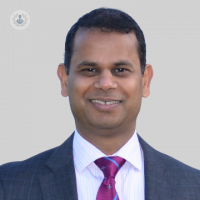How is minimally invasive surgery used in a total hip replacement?
Written in association with:Minimally invasive total hip replacement is a highly successful surgical procedure for the majority of patients with a damaged hip joint. Highly esteemed consultant orthopaedic surgeon, Mr Senthil Kumar Velayudham, provides an expert insight into a minimally invasive total hip replacement and explains the important role of an enhanced recovery programme.

What is minimally invasive hip replacement?
Minimally invasive surgery involves performing total hip replacement through a smaller skin incision, minimal soft tissue dissection and the restoration of soft tissue anatomy. The incision is typically three to five inches long and the muscles are preserved to achieve a good hip function as much as possible. A better understanding of anatomy and an evolution in the surgical technique and instruments have enabled surgeons to perform hip replacements through minimally invasive technique safely.
Total hip replacement can be done through an incision at the back, side or front of the hip. Minimally invasive hip replacement is commonly performed through an incision on the back (posterior approach) or front (anterior approach) of the hip. Each has its own advantages and disadvantages, but there is no evidence so far that overall, one is better than the other. Each surgeon chooses the approach they feel will best achieve good results for their patients.

What are the advantages of minimally invasive hip replacement?
The main advantage is preserved muscle function, which helps the patients to achieve excellent function after the hip replacement. Other advantages are less blood loss, less pain and early recovery. However, there are other important factors to consider as well to achieve these goals, such as the selection of appropriate prostheses, good fixation, placement of prostheses in correct angles and the restoration of the anatomy of the patient’s hip in terms of leg length and soft tissue tension.
Initially, it was thought that minimally invasive hip replacement was the main reason for early recovery and a short hospital stay after surgery, but more evidence is available now, showing that an enhanced recovery programme which optimises every aspect of patient care is crucial to achieve rapid recovery and a reduced hospital stay after hip replacement.
Are there any disadvantages of having minimally invasive hip replacement?
There are no specific disadvantages to having minimally invasive hip replacements, as long as the surgeon has the necessary skill and experience for this type of surgery.
Mr Senthil Kumar Velayudham is a consultant orthopaedic surgeon based in Tunbridge Wells and Crowborough, who specialises in several hip surgeries, including minimally invasive hip replacement, enhanced recovery hip replacement, resurfacing hip replacement, revision hip replacement and hip arthroscopy. If you require a total hip replacement and would like to discuss your options, make sure to visit Mr Velayudham’s Top Doctors profile today.


